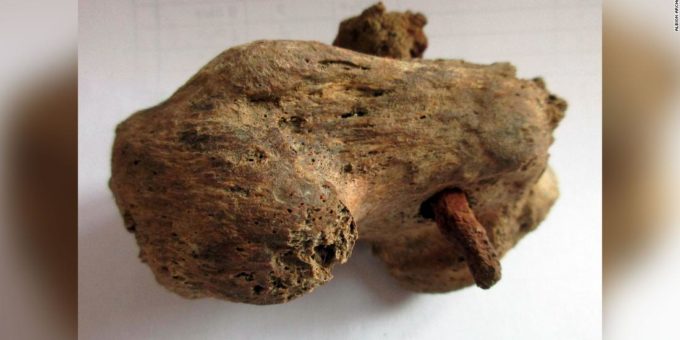
The archaeological team made the discovery while excavating a roadside settlement in 2017, in Fenstanton, which is found on the Via Devana, a road linking the Roman towns Cambridge and Godmanchester.
There are several Iron Age sites in the area, but this settlement, covering at least 6 hectares, is thought to be a later Roman venture on the line of the road, formed in the first or early second century AD, experts said.
Experts discovered five small cemeteries and a few isolated burials, containing a total of 48 individuals.
Among Roman graves at the site, archaeologists discovered the skeleton of a man, between the ages of 25 and 35, with a nail through his heel.
Twelve nails were found around the skeleton, which experts say indicate he had been placed on a board or bier — however, the 13th passed horizontally through the man’s right heel bone.
The man’s lower legs showed signs of thinning, possibly caused by infection, inflammation or irritation from being bound or shackled.
“It seems implausible that the nail could have been accidentally driven through the bone during construction of the timber support on which the body was placed — indeed, there are even signs of a shallow second hole that suggests an unsuccessful first attempt to pierce the bone,” archaeologists explained in a news release.
“While this cannot be taken as incontrovertible proof that the man was crucified, it seems the only plausible explanation — making it at most the fourth example ever recorded worldwide through archaeological evidence,” they said.
Unusual burial
There has only been one other example of a nail surviving through the bone, experts from Albion Archaeology said. This was in Giv’at ha-Mivtar in north Jerusalem during building work in 1968. Skeletons with a similar hole have been discovered in Gavello in Italy and at Mendes in Egypt, but without a nail in place and doubt as to how the holes were formed.
“Crucifixion was relatively commonplace in Roman times, but the victims were often tied to the cross rather than nailed, and if nails were used then it was routine to remove them afterwards,” they added.
“The remarkable fact about this skeleton is not that the man was crucified, but that his body was reclaimed after death and given a formal burial alongside others, leaving us with this extremely rare evidence of what had happened to him.”
Excavation of the settlement also revealed enclosures, away from the domestic sites. One of the enclosures contained large numbers of animal bones, suggesting a large-scale industrial operation, where cattle bones were being split for marrow and grease for the manufacture of soap or tallow for candles.















